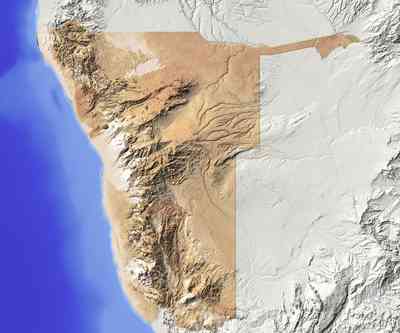
Advanced stage uranium explorer Deep Yellow Limited (ASX:DYL) (PINK:DYLLF) is pleased to announce that its wholly-owned Namibian operating entity, Reptile Uranium Namibia Ltd (‘RUN’) has made a new alaskite discovery at target MS7, which was recently identified from structural and geological mapping. MS7 is only 2.5 kilometres southwest of the company’s Ongolo Alaskite deposit, which has a JORC compliant resource of 6.9 Million tonnes at 410 ppm for 6.2 Million Pounds U3O8 at a 275 ppm cut-off. Ongolo is a key component of the Company’s flagship Omahola Project.
Deep Yellow Managing Director Greg Cochran said the company was excited by the results as they demonstrated an enhanced level of structural understanding which enabled such outstanding targeting. He added that he was optimistic that RUN would continue to make similar high grade intercepts along the Ongolo-INCA trend and thereby further augment the Omahola Project resource base.
MS7 discovery and exploration activities
Drilling commenced with four RC rigs on 19 May 2011, with immediate encouragement from chip logging and downhole gamma logging returning high eU3O8 results. Given that it was a new discovery that appears to be geologically aligned with mineralisation at Ongolo where matrix problems (biotite platelets) negated the use of powder XRF (see release dated 13 December 2010), the company took a conservative approach to first do fusion XRF chemical assays before disclosing the results. Although there are believed to be no disequilibrium issues it should be noted that the eU3O8 does not correlate directly with the fusion XRF (or ICP MS) chemical assay values at Ongolo. eU3O8 results at Ongolo could only be utilised once enough comparative statistical data was collected to ensure that the gamma results were accurate – this approach will apply to MS7 as well and cause a slight delay in presenting additional results and specifically the eU3O8 results.
As can be seen from the cross-section of drill holes ARAD209 and 210 in
Figure 2 (see link at the bottom of the release), mineralisation occurs from near surface and given these holes are 100 metres apart across strike, potential exists for up-and-down dip extensions.
To date 60 RC holes have been completed for 12,078 metres with 20 planned holes remaining which will be complete by the end of July. The deepest hole drilled to date is 276 metres, but generally a vertical depth of 200 metres is being tested except where the hole is in mineralisation at that point.
On completion of this planned programme three RC rigs will be redeployed to the Ongolo Resource area to continue the grid drill-out for additional resources while the remaining rig will commence reconnaissance evaluation of MS3 where initially five priority holes will be completed out of a possible 25, pending results.
INCA FS follow-up results
RUN has now completed 46 RC holes and one diamond hole at INCA FS for a total of 7,700 metres since the discovery hole INCR388 was announced in November 2010 and follow-up evaluation drilling recommenced on 21 April 2011. Drilling was initially all 60 degree inclined until 11 May 2011, when this approach was changed to vertical drilling as a result of the complex structure. The deepest hole drilled to date is 205 metres and generally a vertical depth of 150 metres is being tested.
Ongolo Alaskite deposit update
Infill grid drilling continued after announcement of the initial JORC resource until the RC rigs were moved to MS7. Encouragingly, assays received from this drilling continue to deliver promising results that are likely to increase the JORC Code Resource Estimate.
RUN has two diamond drill rigs on site completing 10 HQ core holes following the recommendations of its resource consultants, Coffey Mining, to infill certain portions of the resource area at 25 metre spacing. This should allow for a better understanding of the structure enhancing confidence and allowing Coffey to revisit its interpretation with the objective of further increasing the size of and confidence in the resource. The RC portion of this exercise has been delayed in favour of assessing the outer perimeters of the resource area and to determine whether it joins up with MS7 and potentially to MS3, MS8 and ultimately INCA, INCA S and then INCA FS.
The distance from Ongolo in the north to INCA FS is approximately 15 kilometres.
Conclusion
Commenting on the regional geology of this part of RUN’s exploration tenements, Greg Cochran acknowledged that the company has much drilling to complete to fully understand the intriguing mineralisation system that has now been located intermittently over many kilometres. He added that the Company’s geologists were busy unravelling the complex structural history and controls on localisation of the high-grade areas of mineralisation, thus allowing more effective targeting.
The alaskite, which occurs over many hundreds of square kilometres in the area, hosts a number of low, medium and higher-grade deposits of uranium generally containing between 100 and 250 ppm U3O8. These grades, in DYL’s estimation, are not currently economically viable which drives its exploration strategy of looking for and only reporting on those areas with plus 400 ppm U3O8 and by employing cut-off grades of 250 to 275 ppm U3O8.
“We also recognise the large volumes of lower-grade mineralisation associated with these higher grade areas – these could boost an existing operation’s production and mine life in years to come for DYL should the economics allow it” Mr Cochran said.
Read the full news release here.